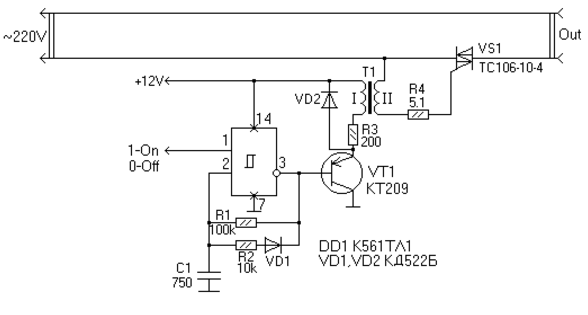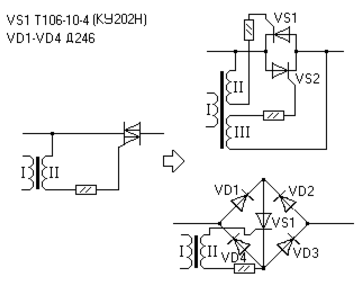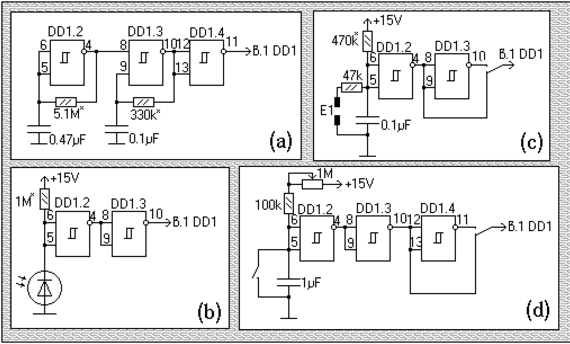
|
|
ENCYCLOPEDIA OF RADIO ELECTRONICS AND ELECTRICAL ENGINEERING Switching mains voltage using triacs. Encyclopedia of radio electronics and electrical engineering
Encyclopedia of radio electronics and electrical engineering / Clocks, timers, relays, load switches In amateur radio practice, quite often one has to deal with the problem of switching the mains alternating voltage. Previously, electromagnetic relays were used to turn on and off the mains load, but as time has shown, this is not the most reliable way: relay contacts are very susceptible to wear, especially when used in AC circuits and especially with inductive loads. Moreover, to turn on powerful consumers, large-sized relays with a significant control current in the winding are needed. Fortunately, the modern element base makes it possible to get by with only semiconductor devices, without using electromechanical ones. So, it is very convenient to switch various network loads using triacs. These semiconductor devices make it possible, under the influence of control powers of the order of 40-50 mW, to switch a network load up to tens of kilowatts (depending on the type of device). Next, consider the most convenient circuit solutions for triac control. The general principles of triac control are approximately the same as for conventional thyristors: if a direct current of one to tens of milliamps flows through the control electrode into the thyristor cathode, then as soon as a potential difference of about 1.2-1.5 V occurs between the anode and cathode of the thyristor, it opens and remains in the open state until the current through it decreases to almost zero (more precisely, to the holding current). The triac is a little more difficult to open, since the polarity of the control voltage relative to the "cathode" (not connected to the output case) must be the same as the polarity of the voltage on the anode (case) of the device. Therefore, if the triac is used to switch the AC mains voltage, then the control device must be able to produce an AC control voltage, which is rather problematic when using control devices on logical ICs. One solution to this problem is to use an optocoupler. The current through the LED of the optocoupler can be the same direction all the time, and the direction of the current through the photoresistor will change with each half-cycle of the mains voltage, ensuring the opening of the triac. If the optocoupler is diode or transistor, then two of them must be used to control one triac.
I can't help but mention optothyristors as well. In one case there is a thyristor and an LED. But, unfortunately, for some reason they don’t make optosimistors, but this is actually a “bourgeois” solid-state relay - an ideal device for switching mains voltage. So, using optothyristors, it is also quite easy to switch the mains voltage (Fig. 2)
The triac can also be controlled by pulses: the control voltage is present on the control electrode for only 5-50 μs, at the moment the mains voltage begins to rise after passing through 0. Moreover, by changing the time position of the control pulse within 0-10 ms relative to the beginning of each half-cycle, you can adjust the power given to the load in the range from 100 to 0 percent. Pulse control also makes it possible to make the control device more economical, and the use of pulse transformers will also make it possible to galvanically isolate the network and the control device. The use of transformers has another advantage: due to self-induction surges under the action of a unipolar pulse, a short packet of rapidly decaying, naturally, bipolar oscillations is formed, which easily opens any triac. If the device being designed is not intended for power control, but should only turn on / off the mains load, then the control pulses may not be synchronized with the passage of the mains voltage through 0. It is enough just to apply them to the control electrode of the triac with a sufficiently high frequency so that, under the most unfavorable conditions, the voltage on the closed triac does not have time to grow to more than a few volts before the arrival of the control pulse. With this control method, oddly enough, the level of interference induced into the network is much less than with synchronized control. A practical circuit of the mains voltage switch, where the principle described above is used, is shown in Fig. 3.
Transformer T1 is made on a ferrite ring 1000-2000 NM size K10X6X4 and contains two identical windings of approximately 50 turns each. Wire for winding in enamel insulation with a diameter of 0,1-0,2 mm. The mutual insulation of the windings is very thorough! The phasing of the windings is indifferent, since due to the VD2 diode, bipolar pulses are induced on the secondary winding. Selecting the resistor R2 regulate the duration of the control pulse. The smaller it is, the lower the current consumption of the control device, but with a very short pulse, not all thyristors have time to open, therefore, if increased efficiency is needed, R2 will have to be selected at the border of a clear opening of the triac. It is possible to reduce the current consumed by the control system to less than 10 mA, which is very convenient in the case of power supplies with capacitive ballast. Using the control circuit shown in Fig. 3, the network load can also be switched on using a pair of conventional thyristors, it is only necessary to supplement the transformer with another of the same winding, and replace the triac with thyristors, as in Fig. 4. You can also use one thyristor, but include it in the diagonal of the diode bridge of the appropriate power.
Now many foreign-made electronic components have become available to radio amateurs. There are triacs among them, perfect for turning on / off network loads. The most affordable and common today are triacs manufactured by Philips types BT134-500 and BT136-500. These devices are made in plastic cases: BT134 - like the KT815 transistors, but without a hole, and BT136 - like the KT805 transistors, with a mounting flange. According to sellers, BT134 is rated for 6A, and BT136 is 12A, but on many sites you can see that both triacs are rated for current no more than 4A and can withstand a voltage of 500 V in the closed state. Unfortunately, the author was not able to view the documentation from the Philips website, since there are all PDF documents, and there is no viewer for the latest versions under DOS. A distinctive feature of these triacs is not so much their small size (the same cases have domestic TS106-10-... in plastic), but the way they are controlled: these triacs are opened by a control voltage of negative polarity with respect to the "cathode" for any direction of current through triac. And this allows you to abandon the use of optocouplers and matching pulse transformers. A practical diagram of the switch, together with a capacitor power supply, is shown in Fig. 5.
The current consumption of the control device in the "off" state is 1.2 mA, and in the "on" state - 5 mA, which made it possible to use a very small capacitor 0,2 μF 400 V in the power supply. The device (Fig. 5) is actually the basis for many electronic devices, because on three free logic elements DD1 you can collect a lot of interesting things. On fig. 6(a) shows a diagram of a flasher, 6(b) - a photo relay, 6(c) - an automatic machine for turning the pump on / off when the sensor E1 touches the water surface, 6(d) - a time relay. It is quite easy to implement a touch switch (Fig. 7).
True, when building generators on logic elements, when using light indication, the consumed current may increase, and then the capacitance C1 will have to be increased. It is quite simple to select the required capacity: in all operating modes, the devices measure the current through the zener diode, it must be at least 1-2 mA and not more than 30 mA. The most commonly used capacitance C1 is 0.47 or 0.68 uF * 400V. The load power switched by the devices discussed in this article depends only on the type of triac (thyristors) and the thickness of the wires :-) see table 1. Table 1. Permissible load power for different types of triacs and thyristors
The table also gives the approximate dimensions of the heatsinks. In general, given the voltage drop across an open triac, which is approximately 1 V, it can be assumed that the power dissipated in the triac is numerically equal to the current passing through it. To dissipate such power, you need a heat sink of the same area as a square plate, with a side numerically equal in centimeters to the dissipated power. The article does not provide data and diagrams regarding the use of triacs KU208G. This is no coincidence, since these triacs showed their worst side and did not work reliably in any device. Many KU208G samples of different years of production had an unacceptably high current in the closed state, and after a long stay under voltage, it was in the closed state that they heated up strongly and then a breakdown occurred. Maybe they need to be included in some special way? I also consider it my duty to remind radio amateurs about electrical safety, since many of the above circuits have a galvanic connection to the network! Do not tempt fate and unplug devices before you climb into them with a soldering iron. Literature
Author: Andrey Shary
Machine for thinning flowers in gardens
02.05.2024 Advanced Infrared Microscope
02.05.2024 Air trap for insects
01.05.2024
▪ MAX30205 - medical digital temperature sensor ▪ The conductivity of the crystal is increased by 400 times ▪ Microchip MIC28514/5 buck converter
▪ radio section of the website. Article selection ▪ article by Immanuel Kant. Famous aphorisms ▪ article How fast did the population of the Earth grow? Detailed answer ▪ article Hazard identification ▪ article Refinement of the AC ammeter. Encyclopedia of radio electronics and electrical engineering ▪ article Miracle water. Focus Secret
Home page | Library | Articles | Website map | Site Reviews www.diagram.com.ua |






 Arabic
Arabic Bengali
Bengali Chinese
Chinese English
English French
French German
German Hebrew
Hebrew Hindi
Hindi Italian
Italian Japanese
Japanese Korean
Korean Malay
Malay Polish
Polish Portuguese
Portuguese Spanish
Spanish Turkish
Turkish Ukrainian
Ukrainian Vietnamese
Vietnamese







 Leave your comment on this article:
Leave your comment on this article: